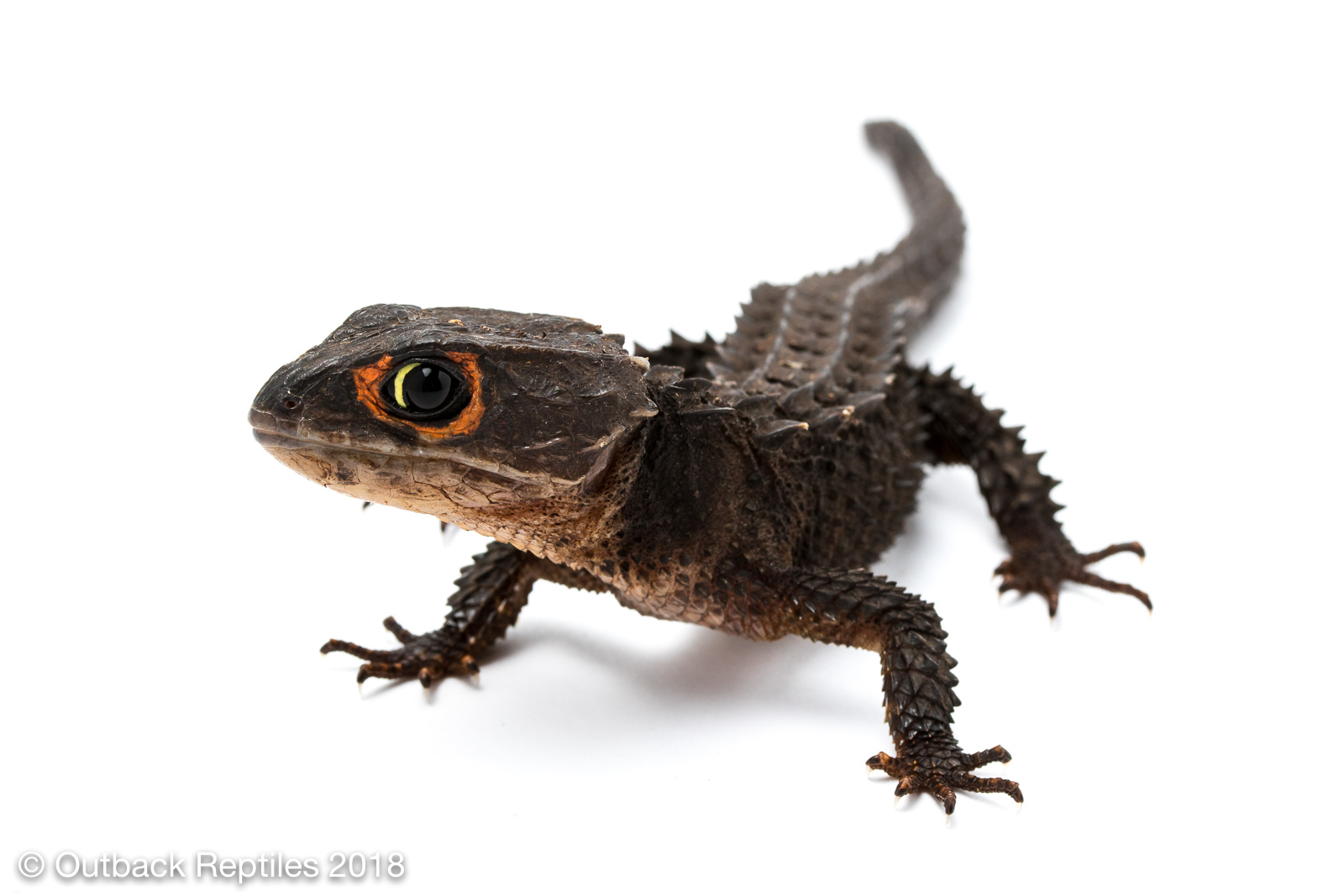Red Eyed Crocodile skinks (Tribolonotus gracilis) are perhaps one of the most popular reptiles we offer for sale. Their prehistoric, dragon like appearance and small size tend to appeal to both expert and amateur keepers alike. Whether you just bought a Croc skink or you are considering picking one up in the near future, it’s imperative that you offer them the best care possible in order to ensure that they thrive in your care.
Red Eye Croc Skinks originate in New Guinea / Indonesia in Southeast Asia. They inhabit tropical rainforest regions and hang out around the swampy creeks and marshes, feeding on insects and worms, and occasionally small fish.
Now, many people keep their animals many different ways. This is my best attempt at putting together the most useful info that I can, based on a decade or so of experience importing , keeping, and selling these creatures. These guidelines work well for us and I am confident they will work for you as well.
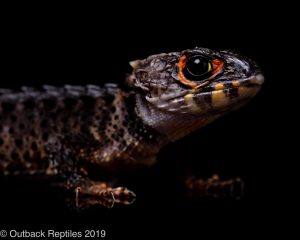
Enclosure
First, you’ll need to set up an adequate enclosure. Most people opt for a glass terrarium type setup, and this is probably the best way to do it if you ask me.
A 15 gallon or 20 Long will suffice for one or two skinks. Exo terra style terrariums (Buy on Amazon here) are a great choice as well, as they provide easy access with front opening doors. Go with at least a 24″ long tank to provide enough space for your Croc Skinks to roam. Remember, these are terrestrial lizards so ground space is much more important than vertical height.
Now to deck out this sweet terrarium! As these are a tropical species, they prefer high humidity in their tank. I try to aim for 60-80% humidity but I am not super scientific about it. As long as it’s generally tropical in there, the lizards will be happy! A damp substrate will help us achieve this goal. There are a few options here – damp moss, cypress mulch, peat moss/potting soil, or coconut fiber/”Eco-earth” type substrates will all work. Use whatever you like best – it’s mainly personal preference for this sort of thing. I like to cover most of the screen lid with plastic or foil to help hold in humidity as well.
This substrate should be kept damp, but not sopping wet. This will help keep conditions inside the terrarium nice and humid, the way Crocodile skinks like it.
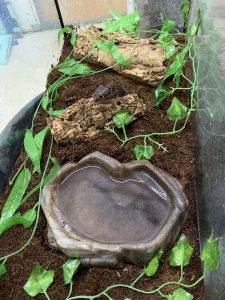
A medium to large water dish is also a necessity. Red Eyed Croc skinks are very fond of spending time in the water, so make sure to choose a dish or bowl that they can easily access. Always make sure it’s shallow enough that the lizards cannot get stuck inside and drown. I usually bury the dish partially so that they can get inside easily, and I leave a few small river stones in the water to provide a sort of stairway back out of the dish should the skinks choose to swim (And they will!) Another bonus is that a large, shallow dish will also aid in keeping those mid to high humidity levels we are aiming for. Note: Always use spring water or tap water that has been treated to be reptile safe. Tap water has chemicals that can harm your skinks, so do not use it straight out of the faucet!
The last thing we’ll need to cover is a handful of hiding spots for your skinks. Red Eyed Crocodile Skinks are pretty shy creatures, so they spend a lot of their time hidden underneath cover. I always provide a few different options, especially if I’m keeping multiple lizards in a single enclosure. This way your pet skink can decide which spot it likes best, or if there are other lizards hanging out together, they can find suitable hiding spots without piling on top of each other and competing for cover.
Cork bark, pieces of wood, or dedicated plastic hide boxes are all great choices. Make sure that whatever you use, there’s no way that the hide can shift and crush whatever is underneath. These guys will dig out a little hidey hole underneath and sometimes this can cause shifting. Never use heavy rocks or anything that can squish your skink.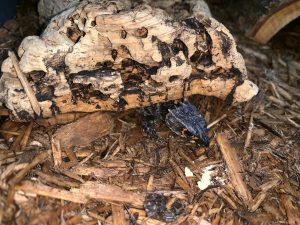
Many people will add plants, vines, etc, whether live or artificial. This is optional and purely up to you, but I personally prefer to add some foliage to give my terrariums a naturalistic look. Whether it’s plastic plants or a live pothos, it can add a really nice natural touch to your setup.
Heating? Lighting?
Should you provide special lighting or heating for your Red Eyed Crocodile skink? This depends, and is also a subject of much debate.
First of all, Red Eyed Crocodile skinks thrive in temperatures ranging from about 75-80 degrees. I typically keep ours right around 78 degrees and they thrive under those conditions. Temperatures between 80-85 start getting too warm for them, and anything over that will certainly cause problems (read: they may die).
So, think to yourself: Do you have a room where you can reliably keep the temperature in this range? Is your house drafty, or does it get especially hot in the summer time? Some keepers may opt to use a small heat pad under their terrarium. If you go this route, you absolutely must use a thermostat to control the temperature. Otherwise, your terrarium could be subject to unforeseen temperature spikes which can harm your skink. Zoo med makes a decent budget-friendly Digital thermostat that will suit the needs of a basic Croc Skink setup (Buy here). I always keep an eye on the temperature with a secondary thermometer just in case there is an issue with the thermostat, for my own peace of mind.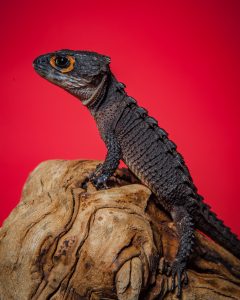
So now the topic of debate. Do Tribolonotus gracilis require full spectrum UV lighting? While some basking activity has been observed, this species is primarily nocturnal, with some crepuscular behavior (active in the early morning and late evening). Since my skinks are hiding under cover for almost the entire daylight cycle in our building, I personally do not provide UVA/UVB lighting for my skinks and I have never had any of the problems associated with many desert dwelling reptiles that do require it. However, if your terrarium has live plants in it, then you’ll need full spectrum lighting anyways, and it cannot hurt. So many people provide a fluorescent UVA/UVB bulb anyways, even though it is not necessarily required for this species. Make sure whatever bulb you choose does not give off any heat(We don’t want to overheat our lizards, remember) – I would steer clear of any basking bulbs and stick with a fluorescent tube or a spiral shaped CFL bulb.
Diet & Feeding
Red Eyed Crocodile Skinks are almost exclusively insectivores. We feed ours a varies diet of crickets, mealworms, and small dubia roach nymphs. Occasionally I’ll add some minnows into the water dish and my skinks will fish them out.
I feed them about every other day to make sure they stay full and healthy. A handful of crickets per lizard is a good rule of thumb to play by. Most of my skinks will devour 5-6 insects in a sitting, depending on the size of the meal. An adult Red Eye Croc Skink will eat 3/4″ (Large) crickets with ease. Feeding in the evening is the best, as this is when Croc Skinks start to become active and go on the hunt for prey.
Mixing up various insects helps ensure that the skinks are getting all the nutrients they need in order to grow and thrive. Gutloaded crickets and occasionally calcium/vitamin dusted crickets will help make sure your skink gets everything it needs.
Daily Maintenance/Tasks
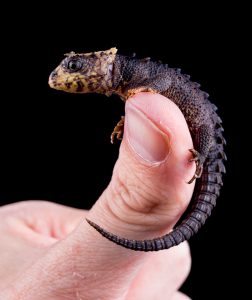
For the most part, Red Eyed Croc skinks will fare best when left alone. I observe my skinks in the mornings and evenings when they are beginning to get active (feeding time!) and I keep handling to a minimum. Picking up your skink occasionally for a health check / quick examination is not going to hurt it, but repetitive handling can stress out your lizard and lead to health issues. A stressed animal will quickly become a sick animal, and Tribolonotus are fairly delicate creatures.
The only thing I’ll really do on a daily basis is a misting/spray down in the mornings and evenings to maintain the tropical environment in the enclosure. I will also do a water check to make sure there is always fresh water available. These guys will climb in and out a lot, which in turn will soil the water with substrate, so I make sure to change it out whenever I notice it’s dirty.
Other than spraying, water checks and feeding I try not to mess with them. These guys prefer being left alone and they will appreciate you for it! Being a responsible pet owner includes knowing which pets can be handled and which ones really shouldn’t be.
Sexing Red Eyed Crocodile Skinks
Red Eyed Croc skinks are pretty easy to sex. Physically, males are typically larger and have much broader heads. This is an easy way to make a quick determination but the fail safe method is to examine the toes of their hind feet.
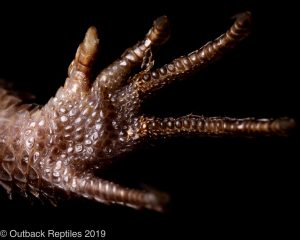
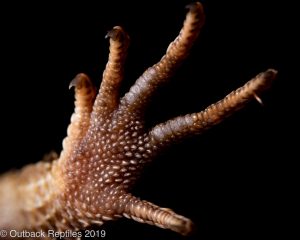
Males will have little white pads at the base of their middle two toes, while females will not. See the images to know what I am talking about. They might be hard to spot at first, but once you know what to look for, sexing Tribolonotus gracilis will be a breeze.
Overview
So we’ve gone into detail; now let’s wrap it up with a quick checklist.
- 15-20 Gallon tank or medium Exo/zoomed/etc. Terrarium with plenty of ground space.
- Damp substrate such as Cypress mulch, spaghnum moss, soil or coconut type bedding.
- Wide, flat water dish with easy access. Fresh spring water or reptile safe water available at all times.
- Hiding spots such as cork bark, coconut hides, pieces of wood, plastic hides
- Stable temperature between 75-80 degrees.
- Daily or twice daily misting.
- Varied insect diet fed 2-3x a week in the evenings.
- Minimal handling
Where to find a Red eyed Crocodile Skink?
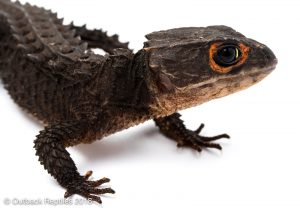 Many importers and resellers carry Red Eyed Crocodile skinks for sale. You can find them for sale on the internet or at local reptile shows. I bring them to most shows we attend, and I also safely ship them across the country nearly year round. As long as the weather/temperature cooperates I ship them with a 100% live arrival guarantee. You can order through our website here and choose a shipping method, or local pickup either here in Manassas, VA or any shows we attend on the east coast.
Many importers and resellers carry Red Eyed Crocodile skinks for sale. You can find them for sale on the internet or at local reptile shows. I bring them to most shows we attend, and I also safely ship them across the country nearly year round. As long as the weather/temperature cooperates I ship them with a 100% live arrival guarantee. You can order through our website here and choose a shipping method, or local pickup either here in Manassas, VA or any shows we attend on the east coast.
Whether you get them from us or somebody else, make sure you do your research and set up your enclosure prior to bringing your lizard home! Always make sure your conditions are set up and stable before introducing your pet to its new home.
Good luck in your Crocodile Skink keeping endeavors, and feel free to shoot us an email or a call if you have any questions or need clarification on anything.
Thanks,
Mike

